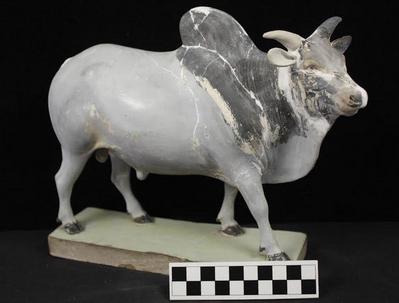E1260: India– Clay Figurine, Bull
Ethnographic
Identifier:
E1260Classification Category:
8:Communication Artifacts ➞ Art/Folk ArtMaterials:
binding agents ➔ joiners ➔ metal wire ➔ armatureclay ➔ ceramic ➔ earthenware
colorant ➔ paint
Dimensions:
24 cm L6 cm W
25 cm H
Provenance of Object:
Figurines such as these are found in numerous places across India, however there is evidence that these figurines are specific to the West Bengal region. For one thing, these figurines are in the Krishnanagar style, and Krishnanagar is a town in the province of West Bengal. Also, the donor, George Winthrop, was stationed in Calcutta, India, which is about three hours from Krishnanagar.Ethnic Group:
Asian ➞ India ➞ West Bengal ➞ KrishnanagarProduction Date:
ca. 1874-1885Use/Function:
Because of its resemblance to Brahman cattle, this figurine was often misattributed to that breed. However, the Brahman is an American cattle breed that was bred from stock native to the Indian sub-continent. Of the more than 30 recognized breeds of Bos Indicus cattle, three strains native to India were used to create the Brahman, the Guzerat, the Nellore, and the Gir.Of these three breeds the most similar in appearance is the Nellore, however the Nellore is similar to the Brahman as it was developed outside of India, this time in Brazil. The Nellore was developed largely from a breed called Ongole.
This is where I hit the jackpot. Based on coloration and body structure of the figurine compared to the picture provided by the source I attribute this figurine to the Ongole breed. The Ongole were developed in the Andhra Pradesh region in Southeast India along the coast. They are used for as draught animals and for milk production.
;According to Dr. Caton, this is likely a Hariana bull because of its smaller hump, longer horns, heads held higher.

